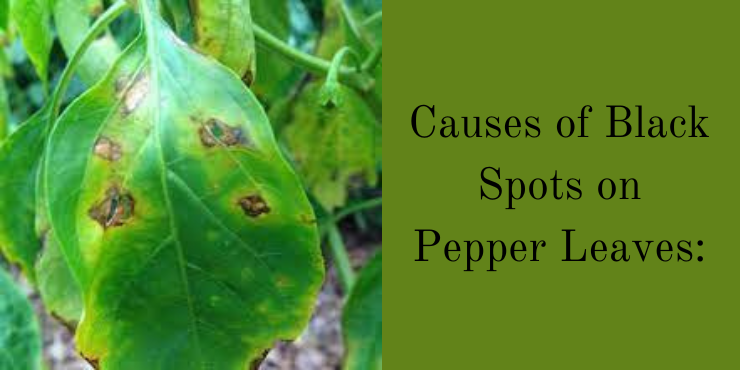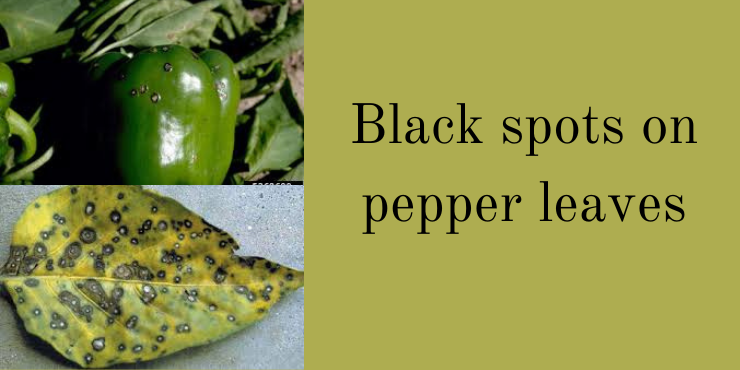Black spots on pepper leaves, Pepper plants, known for their vibrant green foliage and pungent fruits, are a staple in many home gardens and farms. However, the appearance of black spots on pepper leaves can be a cause for concern among growers. In this comprehensive guide, we will delve into the various factors that contribute to the development of black spots on pepper leaves and explore effective strategies for managing and preventing this issue.
Causes of Black Spots on Pepper Leaves:

- Fungal Infections: One of the primary culprits behind black spots on pepper leaves is fungal infections. Pathogens such as Alternaria spp., Colletotrichum spp., and Phytophthora spp. can thrive in humid conditions, leading to the formation of black lesions on the leaves. These fungi often enter the plant through wounds or cuts, emphasizing the importance of proper plant care and hygiene.
- Bacterial Diseases: Bacterial infections, particularly bacterial spots caused by Xanthomonas spp., can also manifest as black spots on pepper leaves. These infections are highly contagious and can spread rapidly in warm and moist environments. Copper-based sprays are commonly used to manage bacterial diseases, but prevention remains crucial.
- Environmental Stress: Pepper plants are sensitive to environmental stressors such as extreme temperatures, inadequate sunlight, and poor soil conditions. When subjected to stress, the plants may develop black spots as a sign of physiological damage. Ensuring optimal growing conditions can significantly reduce the risk of environmental stress-related issues.
- Insect Pests: Certain insect pests, such as aphids and spider mites, can feed on pepper plants, causing damage to the leaves. The feeding activity of these pests can create small wounds that serve as entry points for pathogens, leading to the formation of black spots. Implementing integrated pest management (IPM) practices is essential for preventing pest-related issues.
Managing Black Spots on Pepper Leaves:

- Pruning and Removal: Promptly remove and destroy any affected leaves to prevent the spread of fungal or bacterial pathogens. Pruning can also improve air circulation around the plants, reducing humidity and creating an environment less conducive to disease development.
- Fungicide and Bactericide Applications:
 Apply appropriate fungicides or bactericides to control the spread of pathogens causing black spots. Copper-based sprays are effective against bacterial diseases, while systemic fungicides may be necessary for fungal infections. Follow product labels and recommended application rates.
Apply appropriate fungicides or bactericides to control the spread of pathogens causing black spots. Copper-based sprays are effective against bacterial diseases, while systemic fungicides may be necessary for fungal infections. Follow product labels and recommended application rates. - Optimizing Growing Conditions: Ensure that your pepper plants are grown in optimal conditions. Provide adequate sunlight, well-draining soil, and proper spacing between plants to minimize environmental stress. Mulching can also help regulate soil moisture and temperature.
- Integrated Pest Management (IPM): Implement IPM practices to control insect pests that may contribute to the development of black spots. Use natural predators, such as ladybugs or predatory mites, and regularly inspect plants for signs of infestation.
- Hygiene and Sanitation: Practice good hygiene in the garden by avoiding overwatering, maintaining clean garden tools, and removing plant debris. These measures reduce the likelihood of creating a favorable environment for disease-causing organisms.
Conclusion:
black spots on pepper leaves may be a common challenge for growers, but with proactive management and preventative measures, it is possible to keep your pepper plants healthy and thriving. By understanding the causes of black spots and implementing effective strategies, you can enjoy a bountiful harvest of peppers and maintain the beauty of your garden. Stay vigilant, prioritize plant health, and watch your pepper plants flourish.


